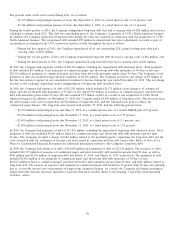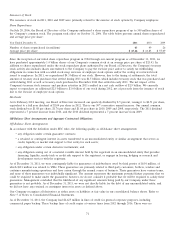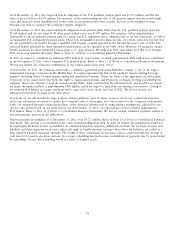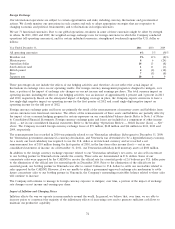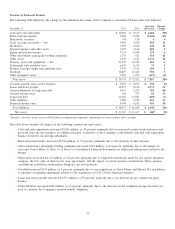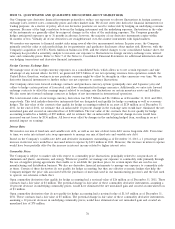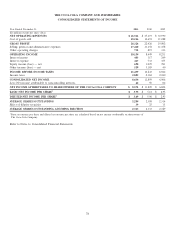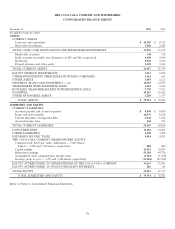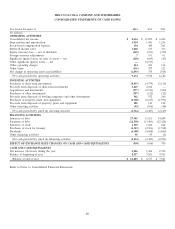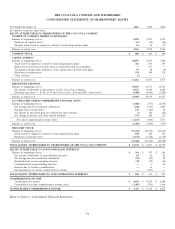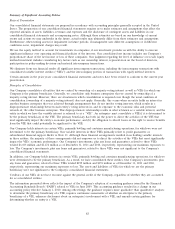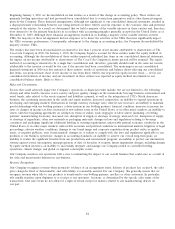Coca Cola 2011 Annual Report Download - page 76
Download and view the complete annual report
Please find page 76 of the 2011 Coca Cola annual report below. You can navigate through the pages in the report by either clicking on the pages listed below, or by using the keyword search tool below to find specific information within the annual report.
Foreign Exchange
Our international operations are subject to certain opportunities and risks, including currency fluctuations and governmental
actions. We closely monitor our operations in each country and seek to adopt appropriate strategies that are responsive to
changing economic and political environments, and to fluctuations in foreign currencies.
We use 73 functional currencies. Due to our global operations, weakness in some of these currencies might be offset by strength
in others. In 2011, 2010 and 2009, the weighted-average exchange rates for foreign currencies in which the Company conducted
operations (all operating currencies), and for certain individual currencies, strengthened (weakened) against the U.S. dollar as
follows:
Year Ended December 31, 2011 2010 2009
All operating currencies 6% 3% (9)%
Brazilian real 5% 11% (8)%
Mexican peso 46 (24)
Australian dollar 14 13 (8)
South African rand 111 (1)
British pound 4(2) (18)
Euro 7(5) (8)
Japanese yen 10 69
These percentages do not include the effects of our hedging activities and, therefore, do not reflect the actual impact of
fluctuations in exchange rates on our operating results. Our foreign currency management program is designed to mitigate, over
time, a portion of the impact of exchange rate changes on our net income and earnings per share. The total currency impact on
operating income, including the effect of our hedging activities, was an increase of approximately 4 percent and 3 percent in 2011
and 2010, respectively. Based on the anticipated impact of hedging coverage in place, the Company expects currencies to have a
low single-digit negative impact on operating income for the first quarter of 2012 and a mid single-digit negative impact on
operating income for the full year of 2012.
Foreign currency exchange gains and losses are primarily the result of the remeasurement of monetary assets and liabilities from
certain currencies into functional currencies. The effects of the remeasurement of these assets and liabilities are partially offset by
the impact of our economic hedging program for certain exposures on our consolidated balance sheets. Refer to Note 5 of Notes
to Consolidated Financial Statements. Foreign currency exchange gains and losses are included as a component of other income
(loss) — net in our consolidated financial statements. Refer to the heading ‘‘Operations Review — Other Income (Loss) — Net’’
above. The Company recorded foreign currency exchange losses of $73 million, $148 million and $34 million in 2011, 2010 and
2009, respectively.
The remeasurement loss recorded in 2010 was primarily related to our Venezuelan subsidiary. Subsequent to December 31, 2009,
the Venezuelan government announced a currency devaluation, and Venezuela was determined to be a hyperinflationary economy.
As a result, our local subsidiary was required to use the U.S. dollar as its functional currency and we recorded a net
remeasurement loss of $103 million during the first quarter of 2010, in the line item other income (loss) — net in our
consolidated statement of income. As of December 31, 2011, our Venezuelan subsidiary held monetary assets of $300 million.
In addition to the foreign currency exchange exposure related to our Venezuelan subsidiary’s net assets, we also sell concentrate
to our bottling partner in Venezuela from outside the country. These sales are denominated in U.S. dollars. Some of our
concentrate sales were approved by the CADIVI to receive the official rate for essential goods of 2.6 bolivars per U.S. dollar prior
to the elimination of the official rate for essential goods in December 2010. Prior to the elimination of the official rate for
essential goods, our bottling partner in Venezuela was able to convert bolivars to U.S. dollars to settle our receivables related to
sales approved by the CADIVI. However, if we are unable to utilize a government-approved exchange rate mechanism to settle
future concentrate sales to our bottling partner in Venezuela, the Company’s outstanding receivables balance related to these sales
will continue to increase.
The Company will continue to manage its foreign currency exposure to mitigate, over time, a portion of the impact of exchange
rate changes on net income and earnings per share.
Impact of Inflation and Changing Prices
Inflation affects the way we operate in many markets around the world. In general, we believe that, over time, we are able to
increase prices to counteract the majority of the inflationary effects of increasing costs and to generate sufficient cash flows to
maintain our productive capability.
74








